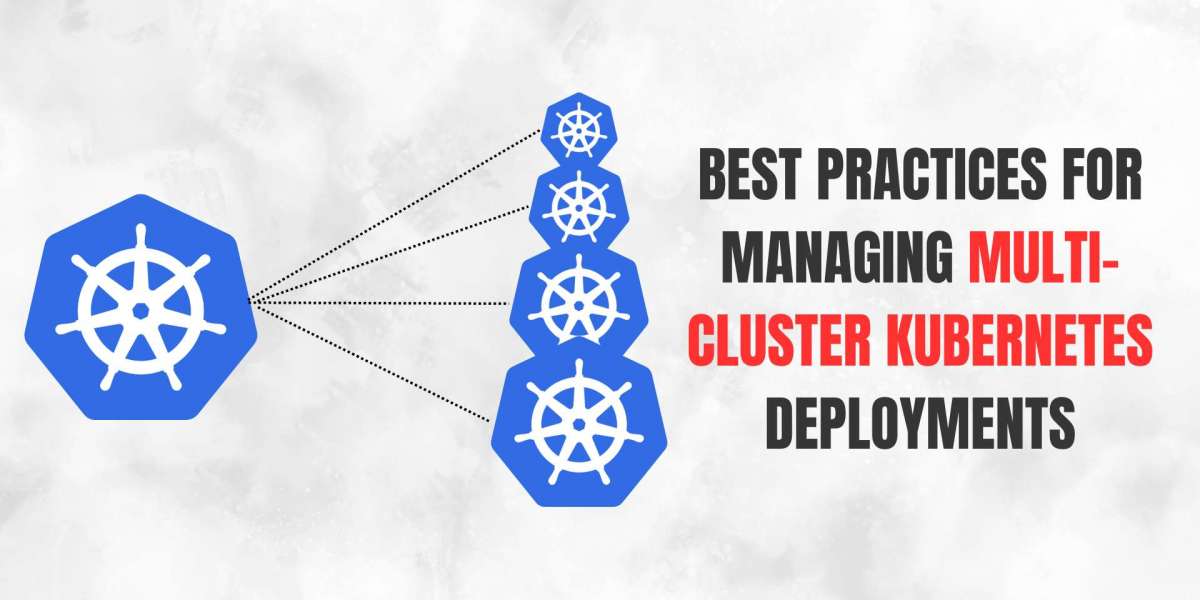Kubernetes has revolutionized the way organizations deploy and manage their applications, providing an efficient, scalable, and reliable system. But as companies grow, the need to manage multi-cluster Kubernetes deployments becomes crucial. Handling multiple Kubernetes node clusters brings its own set of challenges and opportunities. In this guide, we'll cover the best practices for managing multi-cluster Kubernetes environments, ensuring you can scale your deployments efficiently while maintaining high availability and security.
Why Multi-Cluster Kubernetes Deployments?
Before diving into best practices, it's essential to understand why multi-cluster Kubernetes deployments are necessary.
- Geographical Distribution: Organizations with global user bases may need multiple clusters in different regions to ensure low latency and high availability.
- Isolation for Security and Compliance: Some applications or services need isolated environments due to compliance requirements, so multiple clusters offer a way to segregate workloads.
- Resource Optimization: Managing multiple Kubernetes node clusters can help optimize resource allocation by avoiding resource contention between different workloads.
- Disaster Recovery: Multi-cluster environments provide failover mechanisms in case one cluster experiences an outage, ensuring continuous uptime.
With the benefits of multi-cluster deployments in mind, let’s explore the best practices for managing them efficiently.
1. Standardized Cluster Configuration
One of the most critical aspects of managing multiple Kubernetes node clusters is maintaining a standardized configuration across clusters. This practice ensures that all clusters behave consistently, which reduces the risk of configuration drift—a common issue when managing a large number of clusters.
- Version Control: Keep Kubernetes configurations in a version control system (e.g., Git) to manage changes efficiently. Tools like Helm and Kustomize allow for templating and customizing Kubernetes manifests to standardize deployments across clusters.
- Environment Parity: Ensure consistency between different environments (development, staging, production). This is crucial when managing clusters that span multiple environments.
By implementing standardization, you make it easier to automate processes across clusters, reducing manual errors and improving operational efficiency.
2. Centralized Management and Monitoring
When managing multiple Kubernetes clusters, visibility and control are critical. You need a centralized control plane to monitor, manage, and troubleshoot all clusters from one place.
- Centralized Control Plane: Tools like Rancher, Google Anthos, and Red Hat OpenShift offer centralized management, enabling cluster operators to monitor and manage multi-cluster environments through a single pane of glass.
- Observability: Monitoring tools like Prometheus, Grafana, and Elasticsearch-Kibana stacks can help you observe multiple clusters from a unified dashboard. Integrate logging, metrics, and tracing solutions to ensure complete visibility.
This centralization ensures that any issues across your Kubernetes node clusters are easily detected and addressed.
3. Network and Security Considerations
Managing multiple Kubernetes clusters means dealing with inter-cluster communication and securing your workloads across different environments.
- Inter-Cluster Networking: Solutions like Kubernetes Federation, Submariner, and Istio provide ways to manage and secure inter-cluster traffic. These tools help ensure secure communication across clusters by managing service discovery and routing.
- Network Policies: Implement network policies using tools like Calico or Cilium to control the flow of traffic between services within and across clusters. This ensures that only authorized services can communicate, improving security.
- Service Mesh: A service mesh like Istio or Linkerd provides a unified layer of observability, security, and traffic management for services across clusters.
Security should be a top priority when managing multiple Kubernetes clusters, as any breach in one cluster could compromise the entire system.
4. CI/CD Pipelines for Multi-Cluster Deployments
As the complexity of your Kubernetes architecture grows, so too does the need for robust CI/CD pipelines to manage deployments. Continuous Integration/Continuous Deployment (CI/CD) is critical in managing applications that span multiple Kubernetes node clusters.
- Multi-Cluster CI/CD Tools: Platforms like Argo CD, Flux, and Spinnaker offer robust solutions for continuous delivery in multi-cluster environments. These tools enable automated deployment pipelines, ensuring that applications are consistently and reliably deployed across clusters.
- GitOps: Adopting a GitOps model helps manage configurations and deployments by using Git as the single source of truth. GitOps enables you to automate and manage Kubernetes applications across clusters more efficiently, reducing manual intervention.
By implementing robust CI/CD pipelines, you can ensure that applications are deployed consistently across your multi-cluster environment, reducing the chances of misconfigurations or failures.
5. Disaster Recovery and Failover Mechanisms
Ensuring that your multi-cluster Kubernetes environment is resilient to failures is crucial for maintaining uptime and availability.
- Cluster Failover: Implement disaster recovery and failover mechanisms to ensure high availability. Use solutions like Velero for backup and recovery of cluster states, and set up standby clusters that can take over workloads in case of failure.
- Cross-Cluster Replication: Use cross-cluster replication techniques to ensure that data is consistently replicated between clusters. This can be achieved using tools like etcd for state replication, and databases like Cassandra and CockroachDB, which support multi-region replication.
A robust disaster recovery strategy ensures that your services remain available even during a cluster failure or outage.
6. Load Balancing Across Clusters
When dealing with multiple Kubernetes node clusters, load balancing becomes essential to distribute traffic effectively.
- Global Load Balancing: Use global load balancers like Kubernetes Ingress, NGINX, or HAProxy for distributing traffic between clusters. Tools like F5 BIG-IP and Cloudflare also provide load balancing solutions that can route traffic to the nearest or most available cluster.
- Service Failover: Ensure that your load balancer can detect when a cluster is down and route traffic to healthy clusters. A service mesh like Istio can help manage cross-cluster traffic routing and failover.
Proper load balancing ensures that traffic is distributed efficiently across clusters, preventing overloading any one cluster while maintaining high performance and availability.
7. Cluster Autoscaling
Managing the scalability of Kubernetes node clusters is vital, especially as workloads fluctuate.
- Cluster Autoscaler: Use Kubernetes’ Cluster Autoscaler to manage scaling across your clusters automatically. When a cluster reaches capacity, the autoscaler can add nodes to handle the additional load.
- Horizontal Pod Autoscaling (HPA): Implement HPA to scale the number of pods in your deployments based on CPU and memory utilization, ensuring that your applications can handle sudden spikes in traffic.
- Multi-Cluster Autoscaling: Tools like Karmada provide multi-cluster scheduling and autoscaling capabilities, ensuring that workloads are distributed and scaled automatically across multiple clusters.
Autoscaling ensures that your clusters are always operating at optimal capacity, reducing costs and improving performance.
8. Cost Management and Optimization
As you manage more clusters, the cost of running them can escalate quickly. It’s essential to implement strategies to manage and optimize costs effectively.
- Cost Visibility Tools: Tools like Kubecost and CloudHealth provide detailed insights into your Kubernetes spending. These tools help you identify which clusters or workloads are consuming the most resources, allowing you to optimize usage.
- Resource Quotas and Limits: Implement resource quotas and limits across your clusters to ensure that no single workload consumes more than its allocated share of resources. This prevents unnecessary overspending on compute resources.
By proactively managing costs, you can run multiple clusters efficiently without exceeding budget constraints.
9. Security Best Practices for Multi-Cluster Environments
Managing security in a multi-cluster Kubernetes environment is critical for protecting sensitive data and preventing attacks.
- Role-Based Access Control (RBAC): Implement RBAC to manage who can access and modify resources within and across your Kubernetes node clusters.
- Secrets Management: Use tools like HashiCorp Vault or Kubernetes Secrets to manage sensitive information like API keys, passwords, and certificates. Ensure that secrets are encrypted both in transit and at rest.
- Regular Auditing: Conduct regular audits of your clusters to identify potential vulnerabilities. Tools like Aqua Security and Sysdig Secure provide vulnerability scanning and compliance checks across clusters.
Ensuring robust security measures is crucial for safeguarding your Kubernetes environment.
10. Training and Team Collaboration
Finally, ensuring that your teams are well-trained in managing multi-cluster Kubernetes environments is essential for success.
- Training Programs: Invest in Kubernetes training programs for your development and operations teams. This ensures that everyone is familiar with best practices for managing multi-cluster environments.
- Collaboration Tools: Use collaboration platforms like Slack, Jira, or Microsoft Teams to facilitate communication between teams managing different clusters.
By fostering a collaborative environment and ensuring ongoing training, you can manage your multi-cluster deployments more effectively.
Conclusion
Managing multiple Kubernetes node clusters is a complex but rewarding process that can significantly improve your application's scalability, performance, and availability. By following these best practices—standardizing configurations, centralizing management, securing networking, optimizing costs, and implementing CI/CD pipelines—you can streamline the management of multi-cluster Kubernetes environments and ensure your organization reaps the full benefits of container orchestration at scale.








